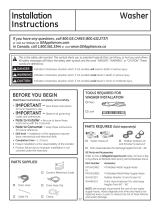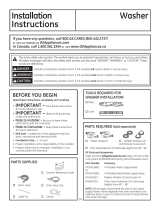
PRE-INSTALLATION REQUIREMENTS
Tools Required for Installation:
1. 3/8 in. socket with ratchet.
2. Channel-lock adjustable pliers.
3. Carpenter's level.
ELECTRICAL REQUIREMENTS
CIRCUIT - Individual, properly polarized and grounded
15 amp. branch circuit fused with 15 amp. time delay
fuse or circuit breaker.
POWER SUPPLY - 2 wire, with ground, 120 volt, single
phase, 60 Hz, Alternating Current.
OUTLET RECEPTACLE - Properly grounded 3-prong
receptacle to be located so the power supply cord is
accessible when the washer is in an installed position.
GROUNDING REQUIREMENTS
Improper connection of the equipment
grounding conductor can result in a risk of electrical
shock. Check with a licensed electrician if you are in
doubt as to whether the appliance is properly grounded.
1.
The washer MUST be grounded. In the event of a
malfunction or breakdown, grounding will reduce the
risk of electrical shock by a path of least resistance
for electrical current.
2.
Since your washer is equipped with a power supply
cord having an equipment-grounding conductor and
a grounding plug, the plug MUST be plugged into
an appropriate, copper wired receptacle that is
properly installed and grounded in accordance with
all local codes and ordinances or in the absence of
local codes, with the National Electrical Codes,
ANSI/NFPA 70 (latest
edition). If in doubt, call a
licensed electrician. DO
NOT cut off or alter the
grounding prong on the
power supply cord. In
situations where a two-
slot receptacle ispresent,
it is the owner's responsi-
_ Do not, under ;,_
any circurNstances,
cut* remove m
orbypassth@
grounding prong. S
Powersupply
cordwith 3- rong
grounding pl_urg
bility to have a licensed electrician replace itwith a
properly grounded three prong grounding type
receptacle.
3.
For added personal safety, connect a separate
ground wire (No. 18 minimum) from a top panel hinge
screw on the rear of the washer to a grounded cold
water pipe. DO NOT ground to a gas supply pipe or
hot water pipe.
4. Grounded cold water pipe MUST have metal
continuity to electrical ground and MUST register no
more than 25 ohms resistance. It MUST not be
interrupted by plastic, rubber, or other electrical
insulating connectors such as hoses, fittings,
washers, gaskets (including water meter or pump).
Any electrically insulated connector should be
jumped with a length of No. 4 copper wire securely
clamped to bare metal at both ends with a UL
approved ground clamp.
5. If a grounded water pipe is not available, a ground
rod MUST be used and register no more than 25
ohms resistance when in the ground. Drive the rod
into the ground outside the dwelling and connect a
grounding wire (12 AWG or heavier) between the
grounding screw and the grounding rod. It may take
more than one ground rod to not exceed 25 ohms
resistance to ground.
WATER SUPPLY REQUIREMENTS
Hot and cold water faucets MUST be installed within 42
inches (107 cm) of your washer's water inlet.The faucets
MUST be 3/4 inch (1.9 cm) garden hose type so inlet
hoses can be connected. Water pressure MUST be
between 10 and 120 pounds per square inch (maximum
unbalance pressure, hot vs. cold, 10 psi.) Your water
department can advise you of your water pressure. The
hot water temperature should be about 140 degrees F
(60 degrees C).
DRAIN REQUIREMENTS
1. Drain capable of eliminating 17 gallons (64.3 L) per
minute.
2. Astandpipe diameter of 1-1/4 in. (3.18 cm) minimum.
3. The standpipe height above the floor should be:
Minimum height: 33in. (83.82 cm)
Maximum height: 96 in. (244 cm)
-f
1" 96" Max.
33" Min. (244 cm)
(83.82 cm)
$ $
NOTE:
For installations requiring a longer drain hose,
have a qualified technician install a longer drain
hose, P/N 131461201. For drain systems in
the floor, install a syphon break kit, P/N
5377678100. Both parts are available from an
authorized parts distributor.
2





